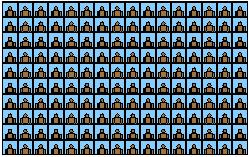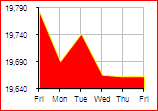La Ola : The Mexican Wave!

(Simulation of Mexican Wave)
Mexican wave (BrE) (AmE the wave) noun: a continuous movement that looks like a wave on the sea, made by a large group of people, especially people watching a football game, when one person after another stands up, raises their arms, and then sits down again.
Now that all of us are decently educated about the concept, allow me to dig deeper into it. La Ola, as its popularly known, first became famous in 1986 soccer world cup in Mexico (hence named Mexican Wave!). It is said that during a particularly boring game someone spilt hot enchilladas on his lap and jumped reflexly, thus originating this phenomena! One Nescafé advertisment claims someone actually spilt his hot coffee and this legend was born. Whatever be the case, soon it got popular among the soccer fans world-wide, especially in Europe.Even after 20 years, this phenomena is quite a rage among sports spectators around the globe. Its popularity has now even reached into the academia! Its is being studied in various world famous centers, in order to learn more about mob controlling during such huge gatherings. Scientists from the University of Budapest have discovered that the "critical mass" required to start a mexican wave is about 25-35 people. A mathematical model is created to represent the wave mathematically. Some very interesting results came out of it like: at a given time the spread is about 15 seats, the speed is about 22 ± 3 seats per second or 12 meters per second. It means the wave will take 38 days to reach the diametrically opposite point on Earth along the equator! Approximately 3 out of 4 mexican waves are clockwise, that means, the wave travels from your right to left. The spreading of the initial "disturbace" depends on how "excitable" the audiance is, they must be seated but ready to be "excited". In other words, they should not be either too bored or too excited! These mathematical models take spectators as "excitable media"; that is, something that can be excited by some sort of external stimulus! Other examples for excitable media would be dry leaves in forest fires or the set of heart muscles, which are excited by small jolts of electricity!
In the end, if you do see, or are involved in, a Mexican Wave, research also tells you that you're not getting your money's worth - because the game is boring, and the crowd are entertaining themselves :)!






1 comment:
Interesting one again.Like most of ur blog posts,I found the content really good but....(u know wat the angrez ki aulaad'll crib abt:-p)To help u with ur "purpose" of blogging,I've got a surprise in store 4 u.Stop tryin 2 guess wat it is n get back to WORK for once.
Post a Comment